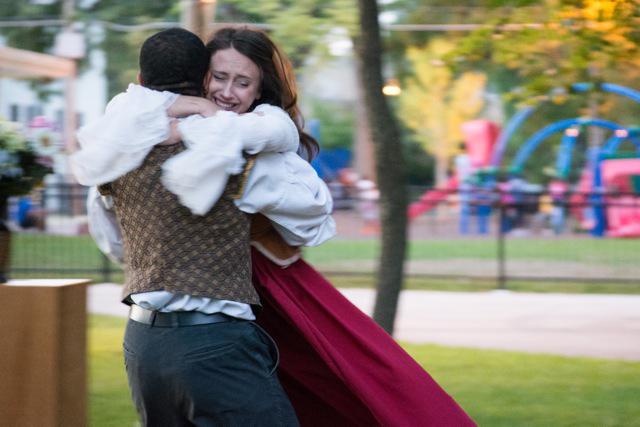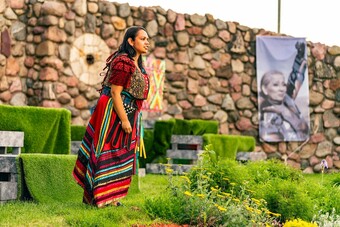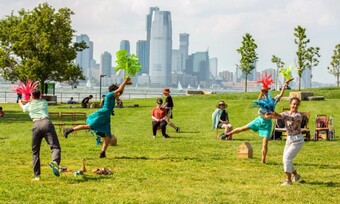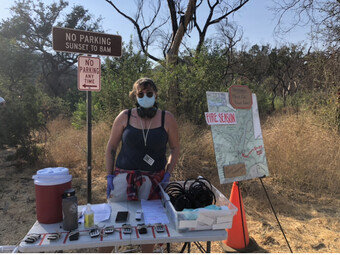Neighborhood Shakespeare in Chicago’s North Side Parks
The idea of free “Shakespeare in the Park” gained popularity as a cultural phenomenon with Joseph Papp’s work beginning in the late 1950s. Papp’s Public Theater’s summer Shakespeare offerings in New York now feature famous actors, high production values, and often require audience members sit in long lines to access free tickets. However, Papp’s legacy began with minimalist productions in neighborhood parks, breaking down both the fiscal and geographic barriers that prevent many people from thinking theater is for “them.” That said, the cultural mystique surrounding Shakespeare sometimes acts as a barrier in and of itself. Ira Glass recently tweeted that Lear is “not relatable” and “Shakespeare Sucks,” kicking up a storm of commentary. Why do Shakespeare in parks? Why not Ibsen, or Sor Juana Inez de la Cruz, or Ntozake Shange?
In August alone, Chicago parks hosted many performances of Shakespeare’s work including Chicago Shakespeare Theater’s A Midsummer Night’s Dream, Spectralia Theatre Company’s Two Gentlemen of Verona and an evening of Shakespeare scenes performed by Shakespeare’s Motley Crew along with Midsommer Flight’s Much Ado About Nothing. In addition, a variety of community-based theater projects were performed in parks, including Free Street Theatre’s series The Park is the Place, About Face Youth Theatre’s Checking Boxes, and Collaboraction’s Crime Scene: Let Hope Rise. Some, though not all, of these projects were supported in part by the Chicago Park District Night out in the Parks program, which has been funding a wide variety of cultural activities in the parks for the last two summers.
On a beautiful evening in early August, my husband and I carried lawn chairs and a picnic to Gross Park, two blocks from our apartment, for Midsommer Flight’s Much Ado. Gross Park spans approximately a city block with basketball courts, a small playground, and a wide grassy field. It is ringed on three sides by brick bungalows and apartment buildings, and borders a section of busy Lawrence Avenue lined with businesses catering more to Albany Park’s immigrant communities than to Lincoln Square’s more affluent residents.
The acting style was broadly comedic and easy to follow (no easy feat, given the complexity of Much Ado’s plot), and the pacing tight—as the performance clocked in at ninety minutes. The words fit comfortably in the actors’s mouths as they made clear sense of the complex language. Martel Manning’s Benedick gave a particularly memorable performance leaping and hiding to eavesdrop on Leonato (Scott Olson) and Claudio (Adam Habben) as they gossiped about Beatrice’s (Ashlee Edgemon) love for him. The audience erupted into peals of laughter at the physical comedy.
The production was bare-boned, performed with a few wooden boxes and bouquets of flowers. A theater with limited funding—without access to big-ticket donors or foundation grants—can find park productions particularly easy to pull off. There is no fee for using Chicago Parks as performance spaces—unlike storefront theater spaces, which, as Midsommer Flight’s Artistic Director Beth Wolf points out, rent for $900-$1000 per week on the low end—and Shakespeare, being in the public domain, requires no royalty payments. Midsommer Flight does not pay its actors, so its major production costs are costumes (for its relatively large cast) and marketing. They raised these funds through small donations (the top donor level listed in its program is $200) and sales of a few program ads.

At times, however, the park itself can act as an obstacle to the performance. Wolf laughs as she discusses a challenge of working in park spaces—“Noise! We have airplanes, we have sirens… [one park] is adjacent to a carwash. There might be kids playing, cars and motorcycles going by—occasionally we get people walking by who holler things at the actors.” It is true, it can be hard to hear the performers as a low flying aircraft bound for O’Hare roars by or the sounds of the basketball game waft over.
The expectations of audience behavior are different in park spaces than in formal theater spaces. Children can dip in and out of the performance, running off to play nearby while their parents watch. Wolf tells a story of a little girl who ran across the stage during last year’s production of Romeo and Juliet, waving “Hi Nu








Comments
The article is just the start of the conversation—we want to know what you think about this subject, too! HowlRound is a space for knowledge-sharing, and we welcome spirited, thoughtful, and on-topic dialogue. Find our full comments policy here
Chicago also saw the collaboration of Theater Oobleck and El Circo Nacional de Puerto Rico in Humboldt Park this summer. It attracted an incredibly diverse audience -- being in both Spanish and English -- but for me the most curious part was having to mentally transport myself to the deck of a ship lost at see as I sat with my children in a large green field of grass under dozens of lush trees, passed by bikers and strollers, etc. I found it incredibly difficult to keep myself immersed in a story that was so at odds with its environment. I'm no expert at creating site-specific work or even just work intended to be consumed in public spaces. But I do think the creative team has to reconcile somehow the liveliness of the space with the story they are trying to tell. Or I -- and perhaps the rest of the audience -- are only ever going to notice the mechanics of the performance as opposed to appreciate the characters they are working so damn hard to convince me are real. http://theateroobleck.com/p...